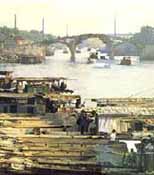 The Grand Canal
The Grand Canal, or the Beijing-Hangzhou Canal, was a giant transportation project of ancient China. With a history of over 1,400 years and a length of 1,794m, it is one of the world’s oldest canals and the longest man-made canal in the world.
The Grand Canal connects Tongxian County of Beijing in the north and Hangzhou, the capital of Zhejiang Province in the south. It flows over Beijing, Tianjin, Hebei, Shandong, Jiangsu and Zhejiang, and connects five large rivers---the Haihe, Yellow, Huaihe, and Qiantang and Yangtze River together. In the late Spring and Autumn Period in the 5th century B.C., a canal was firstly dug near Yangzhou of Jiangsu Province. It was extended during the Sui dynasty in the 7th century, meanwhile other new canals were dug during the period. In 610 A.D., all the canals were connected as a whole and reached to Hangzhou for the first time.
The Grand Canal was the major transport artery between north and south China during the Yuan, Ming and Qing Dynasties, contributing greatly to the economic and cultural exchange between north and south---a role denied to the large natural rivers that mostly flow from west to east. The Grand Canal gained a new lease on life after the founding of the People’s Republic of China. Except for the section in Shandong which is only partly serviceable, many other sections are navigable in some of the seasons while the 800-kilomerer stretch from Jiangsu to Zhejiang opens to year-round shipping.
|


